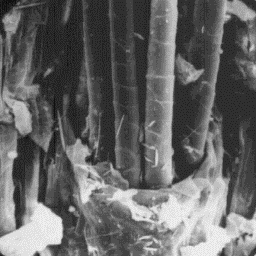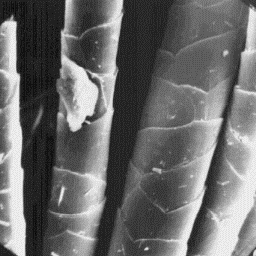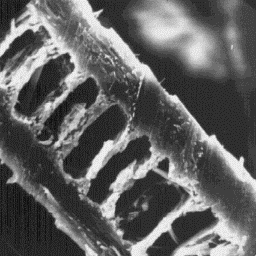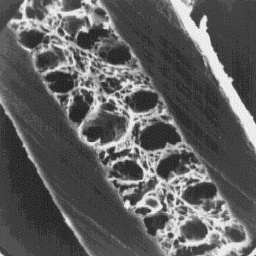 Atilax paludinosus
Atilax paludinosus
------------------
English: Marsh mongoose
German: Wassermanguste
French: Mangouste des marais
Spanish: Mangosta de los pantanos
Distribution areas
------------------
The marsh mongoose can by mainly found
in North and East Africa and in West and
South Asia. A number of similar animals is
known, belonging to species of Herpestes
and Mungos.
Description of the fur The surface structure
---------------------- of the skin, 1000x
The skin is from 45 to 60 cm long, the
tail is about 40 cm. The underfur layer is dense, light-brown in colour and
about 10 to 18 mm thick. The guard hairs are brown in colour and the shafts
are covered with light brown stripes. The fine fur fibres are moderately
curled; the coarser fibres are straight. The guard hair length is from 25 to
35 mm.
|
|
 Atilax paludinosus
Atilax paludinosus
------------------
English: Marsh mongoose
German: Wassermanguste
French: Mangouste des marais
Spanish: Mangosta de los pantanos
Structure of the hair
---------------------
The microscopic structure of the skin
surface is of the grooved type. The upper
part of hair follicle is in close contact
with the hair shaft and the follicle edges
are level with the skin surface. The
average follicle contains a cluster of
hairs. The cuticular structure
of the fine fibres, 2000x
The fine fur fibres are from 7 to 16 µm
in diameter. The cross-sectional outline is circular at the bottom of the
fibre but, in the middle and upper parts, it is elliptical. The cuticular
scales are cornet-like with a regular grooved surface and straight scale
margins. The medullary column is wide, unbroken, central symmetrical-shaped,
and is of the uniserial ladder type with the filling material of an amorphous
structure.
|
|
 Atilax paludinosus
Atilax paludinosus
------------------
English: Marsh mongoose
German: Wassermanguste
French: Mangouste des marais
Spanish: Mangosta de los pantanos
The intermediate fibres are from 20 to
45 µm in diameter. The main part of the
hair shaft is elliptical in cross-sectional
outline. The cuticular scales are crenated
tile-like with a smooth scale surface and
rippled scale margins. The medulla is
narrow and occupies less then one half of
the cross-section. It is unbroken, central
symmetrical-shaped and is of the lattice Longitudinal section
-sponge-like type. of an intermediate fibre, 2000x
The guard hairs are elliptical in cross-section with diameters from 45 to
78 µm. The shafts are covered by cuticles composed of crenated, tile-like
scales. The cuticular surface is smooth and the margins are rippled. The
medulla is narrow, central symmetrical-shaped in cross-sectional outline and
is of the lattice-sponge-like type. The structure of the infilling material
of the medulla is amorphous.
|
|
 Atilax paludinosus
Atilax paludinosus
------------------
English: Marsh mongoose
German: Wassermanguste
French: Mangouste des marais
Spanish: Mangosta de los pantanos
The cuticular structure
of a guard hair, 1000x
|
|
 Atilax paludinosus
Atilax paludinosus
------------------
English: Marsh mongoose
German: Wassermanguste
French: Mangouste des marais
Spanish: Mangosta de los pantanos
Longitudinal section
of a guard hair, 1000x
Numerical code for marsh mongoose skin structure
------------------------------------------------
Surface of the skin: 2-4-3
Fine fur fibres: 1.2-5-2-1-2-1-1-1-8-7.16-8.18
Intermediate fibres: 2-4-1-2-3-1-1-11-5-20.45-20.25
Guard hairs: 2-4-1-2-3-1-1-11-5-45.78-25.35
|




